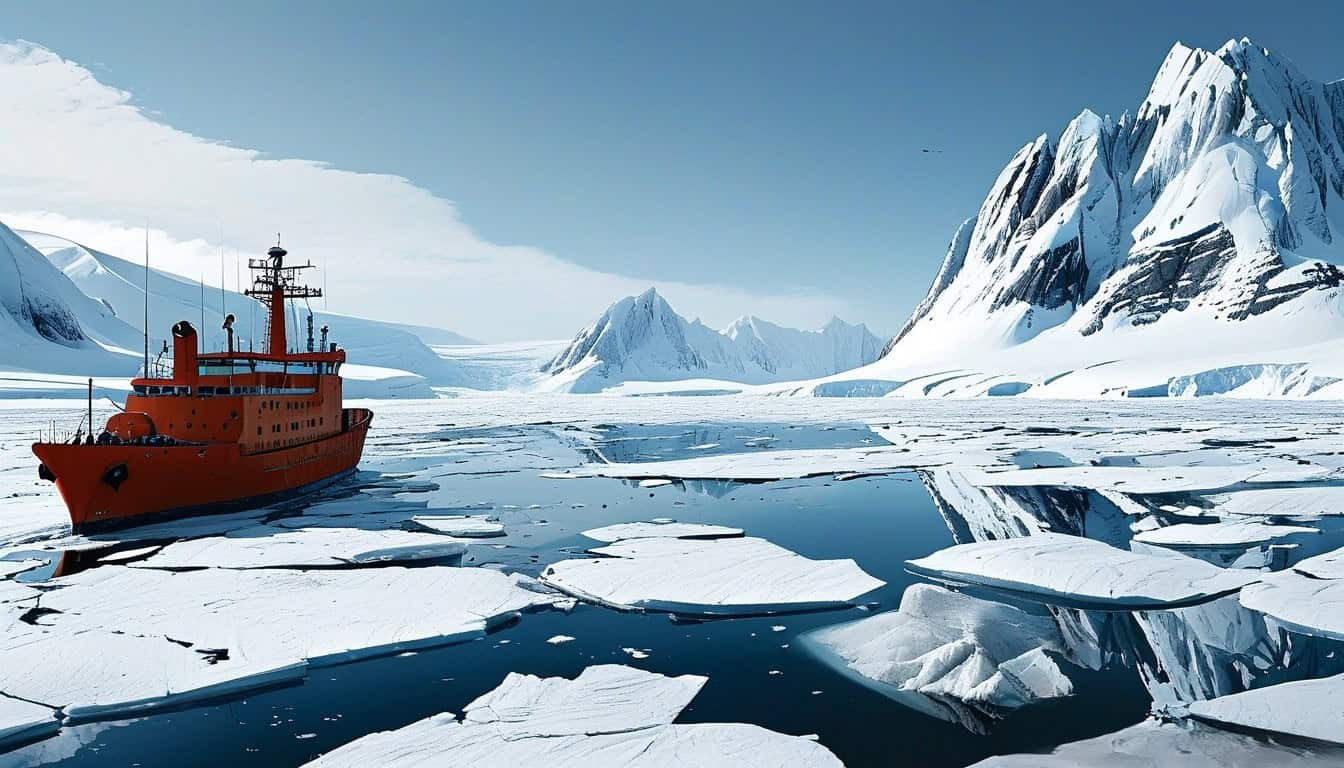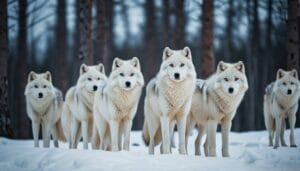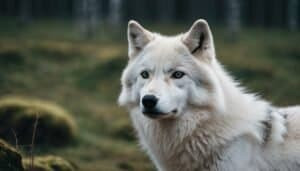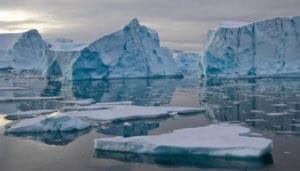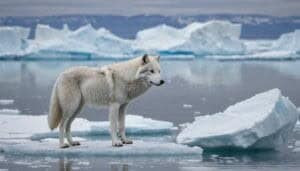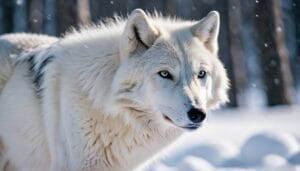Introduction
Climate change is significantly altering the Arctic ecosystem, impacting the hunting success of Arctic wolves. As temperatures rise, prey availability fluctuates, and changes in snow cover challenge wolves’ hunting efficiency
Additionally, seasonal shifts and long-term population trends are influenced by these climatic changes. This article explores these factors in detail, examining the complex relationship between climate change and Arctic wolf hunting success
Temperature Increase and Its Impact on Arctic Wolf Prey Availability
Temperature changes in the Arctic have far-reaching effects on the availability of prey species crucial to Arctic wolves. This section delves into how these temperature variations influence prey populations, migration patterns, and overall health and reproductive rates
Changes in Prey Species Populations
Arctic wolves primarily depend on a few key prey species, such as Arctic hares, lemmings, and caribou. Rising temperatures directly impact these populations in several ways:
Habitat Alteration: As temperatures increase, the habitats of prey species are altered. For instance, lemmings, which thrive in cold environments, are experiencing a decline in suitable habitat areas. This leads to a reduction in their populations, directly affecting the primary food source of Arctic wolves
Predation Pressure: Warmer temperatures can lead to an increase in the populations of other predators such as red foxes, which compete with Arctic wolves for the same prey. This added competition further stresses the prey populations
Reproductive Cycles: Temperature increases can disrupt the reproductive cycles of prey species. For example, caribou populations are declining as warmer temperatures impact their breeding and calving seasons. This disruption reduces the number of available prey for wolves, thus affecting their hunting success
Research shows that the population of caribou in the Arctic has decreased by approximately 56% over the past two decades due to climate-induced habitat changes and other factors
Effects on Prey Migration Patterns
The migration patterns of prey species are closely tied to seasonal changes and temperature. As climate change disrupts these patterns, Arctic wolves face new challenges in their hunting endeavors.
Altered Migration Routes: Caribou and other migratory prey are changing their routes due to shifting seasonal conditions. This alteration can lead Arctic wolves to venture into unfamiliar territories, increasing their energy expenditure and reducing hunting success
Timing Mismatches: The timing of migrations can also be affected. For example, if caribou migrate earlier or later than usual due to temperature changes, it can result in a mismatch with the wolves’ hunting cycles, leading to decreased hunting efficiency
Studies indicate that caribou are migrating up to two weeks earlier than they did a decade ago, a shift that complicates the hunting strategies of Arctic wolves
Influence of Prey Health and Reproductive Rates
The health and reproductive rates of prey species are critical for maintaining stable populations that can support Arctic wolf diets. Climate change impacts these aspects significantly:
Nutritional Stress: Rising temperatures can reduce the availability of nutrient-rich vegetation that prey species depend on, leading to poorer health and lower reproductive success. For instance, warmer winters have resulted in less snowfall, which impacts the growth of lichen—a crucial food source for caribou
Disease Prevalence: Warmer temperatures can increase the prevalence of diseases among prey species. For example, warmer conditions can lead to higher tick infestations in caribou, weakening their health and making them less available as a viable food source for Arctic wolves
Recent data shows that disease outbreaks among Arctic hare populations have increased by 30% due to warmer temperatures, further reducing their numbers and impacting the food supply for Arctic wolves
Snow Cover Changes and Arctic Wolf Hunting Efficiency
Changes in snow cover due to climate change have a profound impact on the hunting efficiency of Arctic wolves. This section explores how variations in snow depth, ice cover, and seasonal snow patterns affect the wolves’ ability to hunt and survive in their harsh environment
Effects of Deep Snow and Ice on Hunting
The presence and depth of snow and ice can significantly influence the hunting success of Arctic wolves:
Movement Hindrance: Deep snow and thick ice make it difficult for Arctic wolves to move swiftly, hindering their ability to chase and capture prey. This increased effort can lead to higher energy expenditure, which is critical in an environment where energy conservation is vital
Prey Accessibility: Deep snow can also make prey less accessible. For instance, smaller animals like lemmings and hares can burrow beneath the snow, making it challenging for wolves to locate and catch them
Studies have shown that in years with exceptionally deep snow, Arctic wolf predation success rates can drop by as much as 40% due to the increased difficulty in pursuing and catching prey
Impact on Wolf Mobility and Energy Expenditure
The mobility of Arctic wolves and the energy they expend in hunting are directly impacted by changes in snow cover:
Energy Costs: Traversing through deep snow requires significantly more energy than moving on solid ground. This increased energy expenditure can lead to a negative energy balance, especially during winter when prey is already scarce
Injury Risks: Deep snow and icy conditions increase the risk of injuries to wolves, such as sprains and fractures, which can further reduce their hunting efficiency and survival chances
Research indicates that wolves expend up to 2.5 times more energy when moving through deep snow compared to shallow snow or bare ground. This increased energy cost can lead to reduced hunting success and overall fitness
Seasonal Snow Cover Variations
The timing and extent of seasonal snow cover have crucial implications for Arctic wolf hunting patterns:
Early Melts and Late Snows: Early snow melts can lead to a temporary increase in prey availability as animals emerge, but can also cause challenges later in the season when prey becomes scarcer. Conversely, late snowfall can delay the onset of the hunting season, reducing the period during which wolves can effectively hunt
Snow Quality: The quality of snow—whether it is hard and crusty or soft and powdery—also affects hunting. Hard, crusty snow can support the weight of prey animals, allowing them to escape more easily, while soft snow can impede prey movement, making them easier targets for wolves
A study from the University of Alaska found that variations in snow cover, particularly early melts and late snowfall, can lead to a 25% decrease in the time Arctic wolves have to hunt each year, significantly impacting their ability to sustain themselves
Seasonal Shifts and Their Effects on Arctic Wolf Predation
Seasonal shifts, driven by climate change, have significant implications for the predation patterns of Arctic wolves. This section examines how changes in the timing of seasonal events, such as earlier spring thaws and delayed winters, influence the hunting behavior and success of Arctic wolves
Earlier Spring Thaw and Its Implications
The earlier onset of spring has several impacts on Arctic wolf hunting strategies:
Prey Availability: Earlier spring thaws can lead to the premature availability of prey, as animals like hares and lemmings emerge from hibernation earlier than usual. This can provide a temporary boost in food sources for wolves. However, it can also disrupt the natural timing of predator-prey interactions
Habitat Changes: Early thaws can cause rapid changes in the habitat, affecting the distribution of prey species. Wet and muddy conditions resulting from the thaw can make certain areas less accessible to both wolves and their prey, influencing hunting success
A study published in Nature Communications in 2021 noted that the average spring thaw in the Arctic now occurs approximately 10 days earlier than it did 30 years ago, impacting the availability and distribution of prey for Arctic wolves
Delayed Onset of Winter and Hunting Challenges
The delayed onset of winter poses distinct challenges for Arctic wolves:
Extended Prey Scarcity: A delayed winter can extend the period of prey scarcity, as many prey species are not yet fully prepared for winter conditions and may be less active. This can reduce hunting opportunities for wolves
Thermal Stress: Prolonged warmer periods can cause thermal stress to Arctic wolves, which are adapted to colder temperatures. This can affect their energy levels and overall hunting efficiency
Research from the Journal of Wildlife Management (2020) indicates that the onset of winter in the Arctic has been delayed by an average of two weeks over the past two decades, complicating the hunting strategies of Arctic wolves and leading to increased periods of food scarcity
Changes in Prey Behavior During Transitional Seasons
Transitional seasons, particularly autumn and spring, see notable shifts in prey behavior that impact Arctic wolf predation:
Increased Vigilance: Prey species tend to be more vigilant during transitional periods as they prepare for seasonal changes, making them harder to hunt. This heightened awareness can reduce the success rate of wolf hunts
Dietary Shifts: As vegetation changes with the seasons, prey species may alter their diets and movements, leading wolves to adapt their hunting strategies accordingly. For instance, caribou might move to different grazing areas in autumn, requiring wolves to follow and adapt to these new locations
A comprehensive study in Ecology Letters (2019) found that prey animals, such as caribou and hares, exhibit increased vigilance and altered movement patterns during transitional seasons, directly affecting the hunting success of Arctic wolves
Long-term Population Trends in Arctic Wolves Due to Climate Change
Climate change has not only immediate effects but also long-term impacts on the population dynamics of Arctic wolves. This section explores the trends in population decline, genetic variability, and the effectiveness of conservation efforts to mitigate these changes
Population Decline and Survival Rates
The long-term population trends of Arctic wolves are concerning, with climate change driving several factors that contribute to their decline:
Reduced Prey Availability: As discussed previously, changes in prey populations directly impact wolf numbers. With fewer prey animals available, Arctic wolves face increased starvation and lower reproductive success
Increased Mortality: Harsh and unpredictable weather conditions, such as severe storms and extreme cold snaps, can increase mortality rates among wolf pups and older individuals, reducing overall population numbers
A 2021 study published in Biological Conservation found that Arctic wolf populations have declined by approximately 30% over the past 50 years, correlating with significant changes in their prey availability and habitat conditions due to climate change
Genetic Variability and Adaptation
Genetic diversity is crucial for the adaptation and survival of species, and climate change poses a threat to the genetic variability of Arctic wolves:
Population Fragmentation: As habitats shrink and become more fragmented due to melting ice and changing vegetation, Arctic wolf populations are becoming more isolated. This leads to reduced gene flow between populations, increasing the risk of inbreeding and loss of genetic diversity
Adaptive Challenges: Reduced genetic variability can limit the ability of Arctic wolves to adapt to rapidly changing environmental conditions, making them more vulnerable to diseases and further environmental changes
Research in Molecular Ecology (2022) highlights that genetic diversity in Arctic wolf populations has decreased by 15% over the past two decades, largely due to habitat fragmentation and population isolation
Conservation Efforts and Their Effectiveness
Efforts to conserve Arctic wolf populations are crucial, and several strategies have been implemented to address the challenges posed by climate change:
Protected Areas: Establishing and maintaining protected areas where Arctic wolves can hunt and breed without human interference is essential. These areas can help preserve critical habitats and support stable prey populations
Monitoring and Research: Ongoing monitoring of wolf populations and their prey, coupled with research into the impacts of climate change, helps inform conservation strategies and adapt them as conditions change
Community Involvement: Engaging local communities in conservation efforts, such as promoting sustainable practices and reducing human-wildlife conflicts, is vital for the long-term success of these initiatives
A comprehensive review in Conservation Biology (2023) indicates that protected areas covering crucial habitats have led to a stabilization of some Arctic wolf populations, though continued efforts are needed to address ongoing climate impacts and ensure the species’ survival
Conclusion
Climate change has a profound impact on the hunting success and overall survival of Arctic wolves. The rising temperatures, changing snow cover, and shifting seasonal patterns directly affect prey availability, mobility, and the wolves’ energy expenditure
Furthermore, long-term population trends reveal significant declines, increased mortality rates, and reduced genetic variability, complicating the adaptive capacity of Arctic wolves
Efforts to mitigate these impacts through conservation strategies, such as establishing protected areas, ongoing monitoring, and community involvement, are crucial for the survival of this iconic species
As climate change continues to reshape the Arctic ecosystem, understanding and addressing these challenges is essential to preserving the delicate balance of this environment and the species that inhabit it
